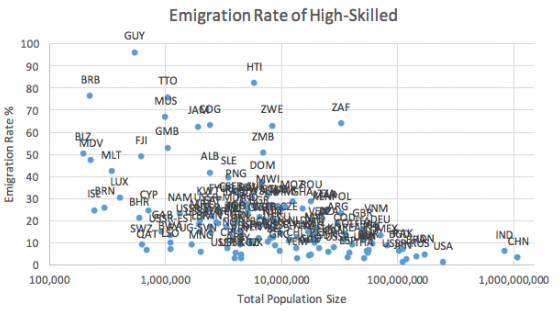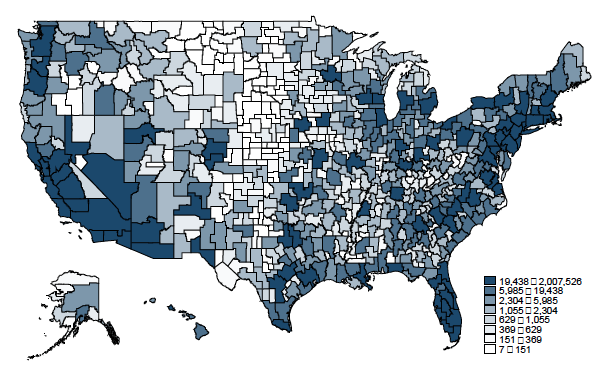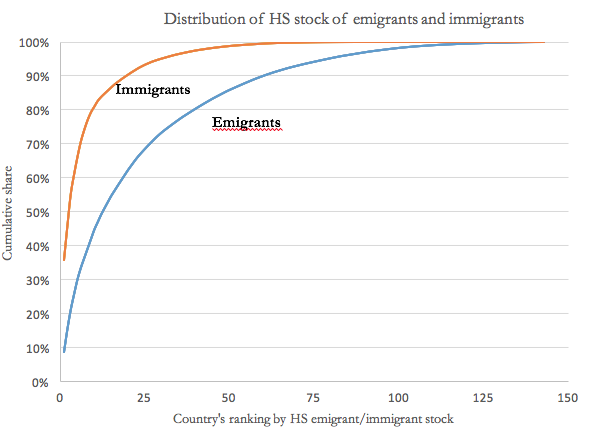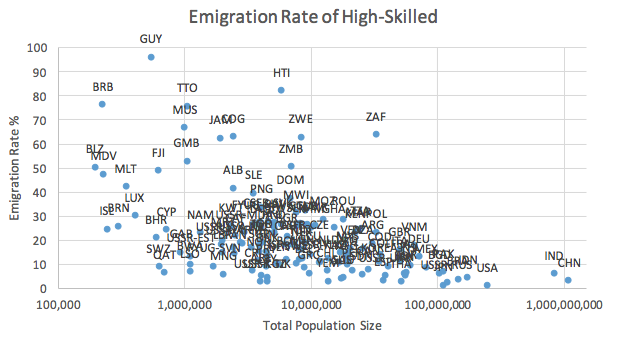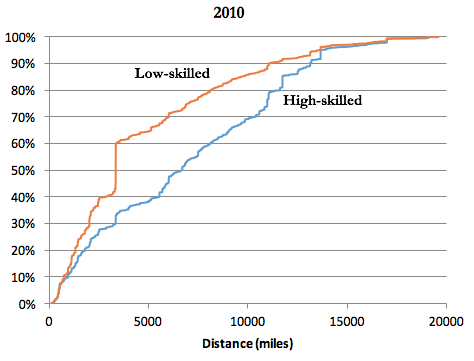High-skilled workers play a central and starring role in today’s knowledge economy. Workers with valuable and transferrable skills have a higher propensity to migrate both domestically and abroad. Yet, not all high-income destinations are equally attractive in the professional and social opportunities they present for immigrants. Countries differ in their geographic accessibility, professional attractiveness, and the degree to which they welcome foreigners. While there is a complex web of factors involved, the central outcome is clear – the flows of high-skilled migrants are very concentrated, both within and across national borders.
This agglomeration of talent has been documented by economists for the upper tail of the talent distribution (Stephan and Levin 2001, Wasmer et al. 2007, Stephan 2010, Weinberg 2011, Kerr 2016), but systematic progress on these important flows has consistently confronted data limitations. In two recent and complementary papers, we provide a systematic review of available global data sources, the observed patterns of high-skilled migration, the role of firms and national policies in shaping these flows, and the underlying agglomeration economies that produce these concentrations (Kerr et al. 2016, 2017). Here we go through some key examples from these findings.
Rapid increase
Overall levels of international migration have been hovering around 3% over the last 60 years. Beneath this perceived stability, global migration patterns have become increasingly asymmetric along several critical dimensions, especially human capital and skills. There were about 28 million high-skilled migrants (defined as at least one-year of tertiary education) residing in OECD countries in 2010, an increase of nearly 130% since 1990. This exceptional rise is the result of several forces – for example, increased efforts by policymakers as they recognise the central role of human capital in economic growth, positive spillovers generated by skill agglomeration, declines in transportation and communication costs, and the rise in the pursuit of foreign education by young people.
Concentration across destinations
While OECD countries constitute less than a fifth of the world’s population, they host two-thirds of high-skilled migrants (OECD 2013, Artuç et al. 2015). Among OECD destinations, the distribution of talent is even more skewed. Four Anglo-Saxon countries – the US, the UK, Canada, and Australia – are the chosen destinations for nearly 70% of high-skilled migrants (to the OECD) in 2010. The US alone has historically hosted close to half of all high-skilled migrants to the OECD and one-third of high-skilled migrants worldwide. The attractiveness of these English-speaking, high-income countries has led other destination countries, such as France, Germany, and Spain, to increase their policy efforts to attract high-skilled workers. Nevertheless, the volume of skilled migration to the four Anglo-Saxon countries, coupled with the significant asymmetry in the concentration of leading universities, high-tech firms and research centres, implies that the global competition for skills will continue to be fierce yet unequal.
Increased concentration with increased skill levels
Agglomeration of talent is even starker within the upper tail of the talent distribution. The Nobel Prizes in Chemistry, Medicine, and Physics, along with the Nobel Memorial Prize in Economics, all provide powerful examples. In the first third of the time period since 1901, 9% of these Nobel Prize winners were born in the US and 13% were affiliated with US institutions at the time of their winning. In the most recent third of the time period, however, academics associated with American institutions have won over 65% of these Nobel Prizes, yet only 46% of this group was born in the US. Of all Nobel Prizes across the four subject areas, 31% (203 of 661) have been awarded to immigrants, of whom 53% (107 of 203) were affiliated with American institutions. The asymmetry of the flows is remarkable. Only four Americans were affiliated with non-American institutions when they received the award, out of 230 total Nobel Prizes being awarded to Americans. Our papers document similar relationships in other settings like professional sports and movie stars.
Concentrated in particular occupations
Many host countries end up with higher concentrations of high-skilled immigrants in particular occupations. For example, immigrants account for some 57% of scientists residing in Switzerland, 45% in Australia, and 38% in the US (Franzoni et al 2012). In the US in 2010, 27% of all physicians and surgeons and over 35% of current medical residents were foreign-born. Immigrants accounted for over 35% of recent enrollments in STEM fields, with very high proportions in specific areas like Electrical Engineering (70%), Computer Science (63%) and Economics (55%) as reported by Anderson (2013).
Concentration within country
Stark inequalities in the concentrations of talent also exist across regions and cities within individual destination countries as demonstrated by Figure 1. We observe significant concentrations of high-skilled migrants in Boston, Northern and Southern California, Chicago, New York City, Miami and Seattle, among others. Our papers document how these spatial concentrations are even sharper in scientific fields and are also present globally – for example, London, New York, Paris, and Milan continue to maintain their positions as the global capitals of finance and fashion.
Figure 1. Distribution of high-skilled migrants in the US, 2010
Notes: Data on high-skilled migrants by Public Use Micro Areas in 2010 are drawn from the 5-year sample of the American Community Survey. These data are subsequently merged to 1990 Commuting Zones using the crosswalk files and weights developed by David Dorn. High-skilled migrants are defined as those with at least one year of tertiary education.
Increase from wider range of origins
OECD countries are increasingly attracting high-skilled migrants from a wider set of origin countries. Figure 2 summarises this pattern by displaying cumulative distributions for high-skilled immigration and emigration stocks in 2010 where origin and destination countries are ranked by the size of their emigrant and immigrant populations respectively. The red line at the top-left of the graph shows the distribution of high-skilled workers in destination countries. This line starts at almost 40%, as the US is the first-ranked country and accounts for the largest share of global immigration flows. As noted earlier, further adding the UK, Canada, and Australia pushes the cumulative share to almost 75%. The second (blue) line graphs the equivalent distribution for emigration of high-skilled workers, with origin countries now ranked by how many migrants they send abroad. The gap between the two lines clearly shows that skilled emigration originates from many countries, even if it flows to relatively few.
Figure 2. Cumulative distribution of high-skilled immigration and emigration, 2010
Notes: Data are from Database on Immigrants in OECD Countries (DIOC) and non-OECD Countries (DIOC-E). High-skilled workers are defined as those with at least one year of tertiary education. The data presented cover people of working age (25+). Countries are ranked according to their share of total high-skilled immigrant inflows and outflows, respectively. These distributions demonstrate that emigration flows have a much wider base relative to the more-concentrated set of immigrant destinations.
Many origin countries have limited educational capacities and fiscal resources to train workers or to replace those that have emigrated. Countries experiencing particularly high emigration rates of high-skilled workers to OECD destinations in 2010 tended to be small, low-income countries, and island states, such as Guyana (93%) and Haiti (82%). Figure 3 demonstrates this inverse relationship between country size and high-skilled emigration rates. Emigration rates are also decreasing in GDP per capita, and these patterns are much starker for high-skilled migration than for overall flows. These movements of high-skilled labour away from certain small and low-income countries have raised controversies about ‘brain drain’.
Figure 3. Emigration rates of high-skilled workers by population, 2010
Notes: Emigration data are from Database on Immigrants in OECD Countries (DIOC) and non-OECD Countries (DIOC-E). High-skilled workers are defined as those with at least one year of tertiary education. The data cover people of working age (25+) and pertain to over 200 origin countries. GDP per capita and population data are from the World Development Indicators of the World Bank accessible at databank.worldbank.org/wdi.
Figure 4 further illustrates that high-skilled migrants tend to travel farther to their destination countries than their less-skilled compatriots. This graph shows the cumulative distribution of distances travelled by migrants of different skill levels in 2010. The median distance travelled by a high-skilled migrant is 7,000 miles, while it is below 4,000 for low-skilled migrants.
Figure 4. Cumulative distribution of migration distance, 2010
Notes: Figure 4 plots the relationship between the stock of immigrants to OECD countries and the distance between their destination and origin countries. The data come from Arslan et al (2014) and refer to those of age 25 or over. Tertiary-educated individuals are defined as high-skilled.
Agglomeration foundation
These high-skilled migration patterns can be explained with agglomeration economies. The presence of high-skilled people in a geographic location – regardless of whether they are natives or immigrants – increases the incentives for additional high-skilled people to move there due to a wide range positive externalities. Many high-skilled occupations and sectors with high migrant shares exhibit such agglomeration effects where individuals’ productivity is enhanced by the presence of, or collaboration with, other high-skilled workers employed in similar or related occupations and sectors.
At the core of the agglomeration process is trade in knowledge services provided by high-skilled people. High-tech companies headquartered in Silicon Valley compete with each other globally; their market is not limited to Northern California. The clusters allow better technology exchanges, deeper labour market specialisation, stronger complementary inputs (e.g. specialised lawyers), and so on. Thus, there is no inherent limit as to how many firms can physically locate in Silicon Valley. On the contrary, the presence of entrepreneurs, engineers and scientists lead to the employment of others like them as they start new firms or expand existing ones.
In the presence of agglomeration effects, migration of the highly skilled into a geographic area or sector need not lead to a decline in returns to skills or to wages. As a result, this mechanism can be quite self-reinforcing as demonstrated in the endogenous growth literature (Jones 1995). Agglomeration effects and spillovers increase the returns to higher skills in one country rather than in others, and may even create sharp differences across regions within the same country. These effects can be accentuated as the economics of firms enter into high-skilled migration movement decisions (Kerr et al. 2015a, 2015b).
These agglomeration factors and their implications for economic growth make the economics of high-skilled migration quite different from those of low-skilled migration. Moreover, the critical role of gatekeepers like firms and universities for national admissions are greatly unexplored compared to their importance. The data necessary to analyse these important patterns are just coming online, and the future research potential is immense.
References
Anderson, S (2013) “The importance of international students to America”, National Foundation for American Policy Brief.
Arslan, C, J-C Dumont, Z Kone, Y Moullan, C Özden, C Parsons and T Xenogiani (2014) “A new profile of migrants in the aftermath of the recent economic crisis”, OECD, Social, employment and migration Working Paper 160.
Artuç, E, F Docquier, Ç Özden and C Parsons (2015) “A global assessment of human capital mobility: The role of non-OECD destinations”, World Development.
Franzoni, C, G Scellato and P Stephan (2012) “Foreign born scientists: Mobility patterns for sixteen countries”, Nature Biotechnology, 30(12): 1250-1253.
Jones, C (1995) “R&D-based models of economic growth”, Journal of Political Economy, 103: 759-784.
Kerr, S, W Kerr, Ç Özden and C Parsons (2016) “Global talent flows”, Journal of Economic Perspectives 30(4): 83-106.
Kerr, S, W Kerr, Ç Özden and C Parsons (2017) “High-skilled migration and agglomeration”, Annual Review of Economics, forthcoming.
Kerr, S, W Kerr and W Lincoln (2015a) “Firms and the economics of skilled immigration”, Innovation Policy and the Economy, 15(1): 115–152.
Kerr, S, W Kerr and W Lincoln (2015b) “Skilled immigration and the employment structures of US firms”, Journal of Labor Economics, 33(S1): S109–S145.
Kerr, W (2016) “US high-skilled immigration, innovation, and entrepreneurship: Empirical approaches and evidence”, in C Fink and E Miguelez (eds), The International Mobility of Talent and Innovation - New Evidence and Policy Implications, Cambridge, UK: Cambridge University Press, forthcoming.
Stephan, P (2010) “The I's have it: Immigration and innovation, the perspective from academe”, in J Lerner and S Stern (eds), Innovation Policy and the Economy, Cambridge, MA: MIT Press.
Stephan, P and S Levin (2001) “Exceptional contributions to US science by the foreign-born and foreign-educated”, Population Research and Policy Review, 20(1): 59-79.
Wasmer, E, P Fredriksson, A Lamo, J Messina and G Peri (2007) “The macroeconomics of education in Europe”, in Brunello, Garibaldi and Wasmer (eds), Education and Training in Europe, Oxford: Oxford University Press.
Weinberg, B (2011) “Developing science: Scientific performance and brain drains in the developing world”, Journal of Development Economics, 95(1): 95-104.
